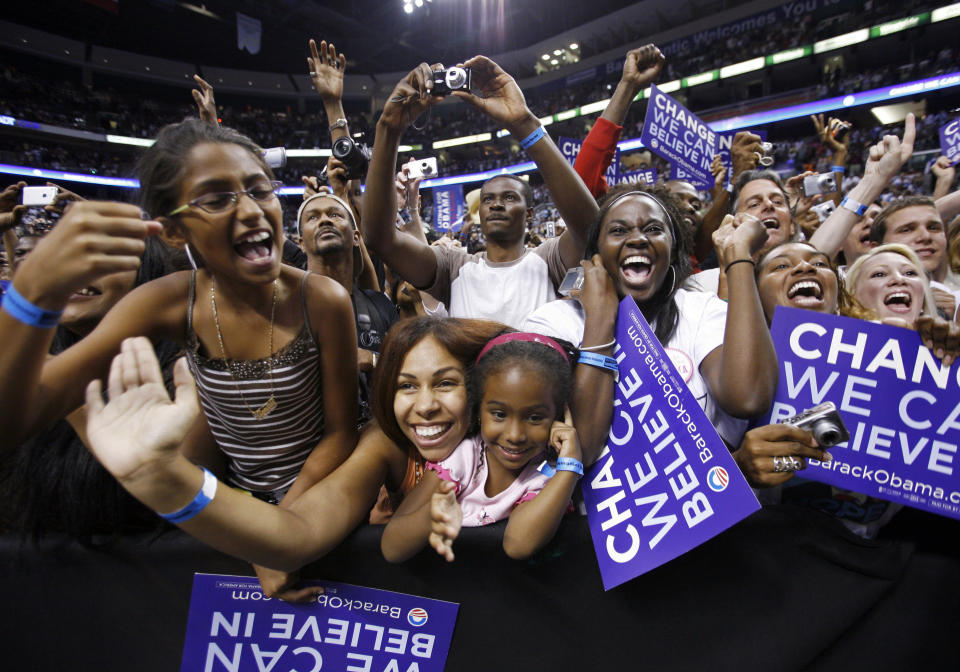Divided by symbols, Americans see a 'serious threat' across the aisle

An annual survey of American attitudes about politics and values released Tuesday found, to no one’s surprise, that the nation’s divisions are growing dangerously deep and wide.
More than half the people in both the Republican and Democratic parties see the other side as a “serious threat to the country,” the American Values Survey by the Public Religion Research Institute (PRRI) found. At a panel discussion at the Brookings Institution to discuss the poll findings, Henry Olsen, a senior fellow at the Ethics and Public Policy Center, said a “pre-Spanish Civil War mentality” was taking hold among voters.
The word “war” itself was mentioned numerous times by the panelists, in reference to the way both left and right see politics now as a zero-sum fight.
The good news — or the bad, depending on how one views it — is that the divisions are mostly not about policy, but symbolism.
“When you’re at war symbols begin to matter more,” said Robert Jones, CEO of PRRI. “Confederate monuments, flags … the [border] wall is part of that.”
But, he added, “If you talk policy, Americans are pragmatic.”
He cited a finding in the latest values survey, which PRRI has conducted for eight years in a row, that around half of Republicans support a path to citizenship for undocumented immigrants. He contrasted that with the political rhetoric from President Trump about building a wall along the U.S.-Mexico border.
“It’s the symbolic issues that are animating more than the actual policy issues,” Jones said. “When you turn from symbols to policy, there’s less polarization.”
There was agreement among the panelists Tuesday, including the conservative Olsen, that Trump fuels the conflict by highlighting the most inflammatory public issues.
But the deeper question is, why are Americans so focused on symbols rather than substance when it comes to choosing and following political leaders? Is it a recent phenomenon, brought on by the age of entertainment over information that has dominated the world since the advent of television? Or is it a natural human instinct?
Joy Reid, a panelist who hosts a weekend show on MSNBC, said that the election of former President Barack Obama in 2008 and 2012 was a symbolic act for many black Americans, and that Trump voters — most of them white — engaged in countersymbolism.

Trump is “almost a flip-side, bizarro-world Obama,” Reid said. “For a lot of hardcore Obama supporters, Obama was the point. It wasn’t specifically that he would do some specific economic thing,” Reid said. “It was the symbolism of having somebody who was not white, somebody who has international roots in his family, somebody who represented a changing America.”
Similarly, Reid said, “For a lot of Trump supporters Trump is the point. It isn’t his policies. It’s not what he’s going to do even for them.”
“Just having that man, who is white and very ethnonationalist in his whitenesss … very proactive about putting forward his gender and racial identity and saying I represent this and I’ll attack the people who in your view are detriments to it … that’s kind of the point,” she said.
Reid said that Democrats who want to “convert” Trump voters may be chasing a lost cause. “I’m not sure that can be done,” she said. “He has a power over at least a third of the country that I don’t think anything can break.”
But while the PRRI study found 15 percent of Trump supporters said there’s nothing he could do to lose their support, there were twice as many confirmed opponents of the president. PRRI asked those who disapprove of Trump if there was anything he could do to win them over, and 33 percent of them said there was not.
E.J. Dionne, a Washington Post columnist who was also on the panel, disagreed with Reid that no Trump voters could be won over. “To me these numbers show that there are a substantial number of Trump voters or supporters who can be converted,” he said, citing Trump’s approval numbers, which are down to 39 percent in the average of all polls, while 56 percent disapprove.
“This is a substantial drop-off from where Trump stood on Election Day 2016,” Dionne said. A year ago, right after he was elected, Trump had a 44 percent approval rating, and a 50 percent disapproval rating.
Olsen’s explanations for the victory of symbolism over substance, and the rise of Trumpism, had more to do with a loss of what Jones called “cultural dominance” combined with economic vulnerability for some of the president’s supporters.
Trump’s voter base “feeds on fear,” Olsen said.
But he cautioned against dismissing them, saying that would only increase the risk of violence.
“If you’re educated and well-off, you tend to look at these reactions as being hopelessly naive, out of touch, racist, irrational and consequently worthy of being ignored,” Olsen said. “If that’s the response, you shouldn’t expect them to give up their arms. … If the answer is basically to build a wall around populism, what you simply do is build up tension, build up the partisanship. And then, if you go through some sort of economic decline that makes even more people despairing, you raise the possibility of a much more dangerous counterreaction.”
_____
Read more from Yahoo News:


